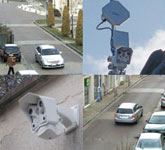

Smaller towns also need effective surveillance.
Villennes-sur-Seine lies about 30 kilometres west of Paris in the middle of a protected nature reserve. With 4788 inhabitants, the small and prosperous city offers its population a very high quality of life. However, repeated incidents involving vandalism, theft and burglary have prompted the city council to install a video surveillance system. This is meant to deter crimes against people and property in areas with a high risk of violence or theft. It also is intended to protect public buildings and institutions against such attacks.
Mobotix cameras were installed at critical locations in the city: at a sports centre, in a parking lot, near three schools, at an underpass, by a train station exit and at the main streets downtown. The city also wanted to use this system to improve and regulate the flow of traffic and to monitor vehicles. High-resolution digital camera was required to identify licence plates of moving cars both day and night, as the police must have high-quality images to prove that a particular vehicle passed a certain location in order to build their case based on such evidence.
Says Pierre-Francois Degand, second deputy mayor and security officer for the city. “The cameras deliver two things: firstly, they deter crime and, secondly, they are useful should an event actually occur. In only a few months, we noticed a decline in petty crime and an increase in cases solved. The system will be expanded by 2011 to include other locations such as intersections.”
City police departments and gendarmeries are the first-line users of the Mobotix video surveillance system. This is backed up by government measures in the form of guidelines which push the development of video surveillance systems in a particular direction.
This includes a French law that requires local councils to install the equipment needed to combat terrorism. This directive stipulates that certain technical standards must be fulfilled in regards to image quality. For instance, a recording must feature 576 vertical line resolution taken at 12 frames per second to guarantee detail enlargements of a person’s face, for example, with a minimum resolution of 90 x 60 pixels. A frame rate of at least 12 frames per second in the recorded video stream is also required. Due to technical limitations, analogue cameras can at best deliver a resolution of between 0,1 and 0,4 megapixels, or up to 4CIF (PAL). It is therefore not possible to zoom in on key details such as the car’s licence plate or faces and hence solve a crime quickly and conclusively. To overcome this shortcoming, a decision was announced to establish binding technical standards that guarantee a minimum level of quality (camera capacity, storage, compression, transfer, image rendering, etc.).
In view of the many laws in this area, digital IP technology is increasingly being used and replacing analogue technology. Mobotix city surveillance cameras are already able to deliver the required solutions and meet the needs of law enforcement for the discovery of evidence. Images are recorded and saved at a resolution of 3 megapixels thanks to image processing in the camera. Police officers find these high-quality images extremely helpful in identifying licence plates and people. Furthermore, the resolution provides a better general overview, which means fewer cameras need to be installed.
For more information contact Industrial Automation & Control, +27 (0)12 657 3600, [email protected], www.iacontrol.co.za
| Tel: | +27 12 657 3600 |
| Email: | [email protected] |
| www: | www.iacontrol.co.za |
| Articles: | More information and articles about Industrial Automation & Control (IAC) |

© Technews Publishing (Pty) Ltd. | All Rights Reserved.